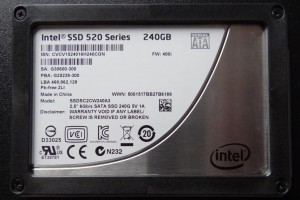SSD EXTERIOR AND COMPONENTS
No different than Intel’s previous SSD releases, the Series 520 case is a metal ultra slim design with a rubber spacer on top that can be removed, if necessary.
The back is unremarkable with only a course unpolished metal surface and the exterior casing can be disassembled through removal of four screws which afford access to the SSDs printed circuit board (PCB) and components.
 The heart and sole of the Series 520 is the LSI SandForce SF-2281 processor. This has been the subject of immense curiosity for several months now as many have doubted Intel’s intentions of manufacturing an SSD with any controller other than their own.
The heart and sole of the Series 520 is the LSI SandForce SF-2281 processor. This has been the subject of immense curiosity for several months now as many have doubted Intel’s intentions of manufacturing an SSD with any controller other than their own.
 Eight modules of Intel’s own 25nm NAND flash memory (29F16B08CCME2) can be found on each side of the PCB, each being 16GB in capacity. These memory chips are Intel’s premium line, this meaning that they are synchronous and will have better performance results when working with incompressible data than the more value driven asynchronous memory has. In examining the PCB closely, we can also see that Intel has stamped their codename ‘Cherryville’ onto its face at the bottom right and lower left on the back.
Eight modules of Intel’s own 25nm NAND flash memory (29F16B08CCME2) can be found on each side of the PCB, each being 16GB in capacity. These memory chips are Intel’s premium line, this meaning that they are synchronous and will have better performance results when working with incompressible data than the more value driven asynchronous memory has. In examining the PCB closely, we can also see that Intel has stamped their codename ‘Cherryville’ onto its face at the bottom right and lower left on the back.
 The total capacity of the NAND flash memory is 256GB, however, one 16GB module is utilized for firmware and over provisioning needs, leaving us with the advertised 240GB capacity. Formatting reduces the available capacity even further and the final storage available to the consumer is 224GB.
The total capacity of the NAND flash memory is 256GB, however, one 16GB module is utilized for firmware and over provisioning needs, leaving us with the advertised 240GB capacity. Formatting reduces the available capacity even further and the final storage available to the consumer is 224GB.
Not understanding the reasoning for their total capacity being 224GB when the advertised storage is 240GB, many become disappointed and some even wonder if their is something wrong with the SSD itself. The simple fact is that the firmwares retention of that 16GB provides significant performance and endurance increases that are the trademark of ‘SandForce Driven’ SSDs. It is a good thing that has contributed significantly to the LSI SandForce success story.
 The SSD Review The Worlds Dedicated SSD Education and Review Resource |
The SSD Review The Worlds Dedicated SSD Education and Review Resource | 

Nice, was wondering when Intel will show their Sandforce SSDs. The prices on the others drop drastically and some have already reach $1/GB after rebate.
If Intel is using the Sandforce 2281 then I dont understand why OCZ bought Indilinx. Obviously Intel had a choice. They are as big as you can get and if they chose Sandforce over the controllers that are in the Samsung SSDs they must be extremely reliable. JMHO.
Can’t wait to see how these babies do in Raid0!
This is an excellent article! Great work Les 🙂 no pressure for me on the followup lol 😉
Fabulous article – I like the detail especially about the 16GBs being used by the firmware.
I’ve read that the 520s do not have capacitors, so if there is a power shut down (happened to me two nights ago) that the information on the hard drive is gone. Is this true?
Can you link your quote? Intel 520’s do, in fact, have data loss protection in the event of power loss. It is part of Intels ‘End To End Data Protection’
https://www.intel.com/content/www/us/en/solid-state-drives/solid-state-drives-520-series.html
would be interested to see a review of the sandisk extreme ssd. it’s by far the cheapest sandforce powered ssd with toggle nand – buy.com has the 120gb for about $160 and 240gb for about $320. that’s a steal. storagereview reviewed it and were very impressed.